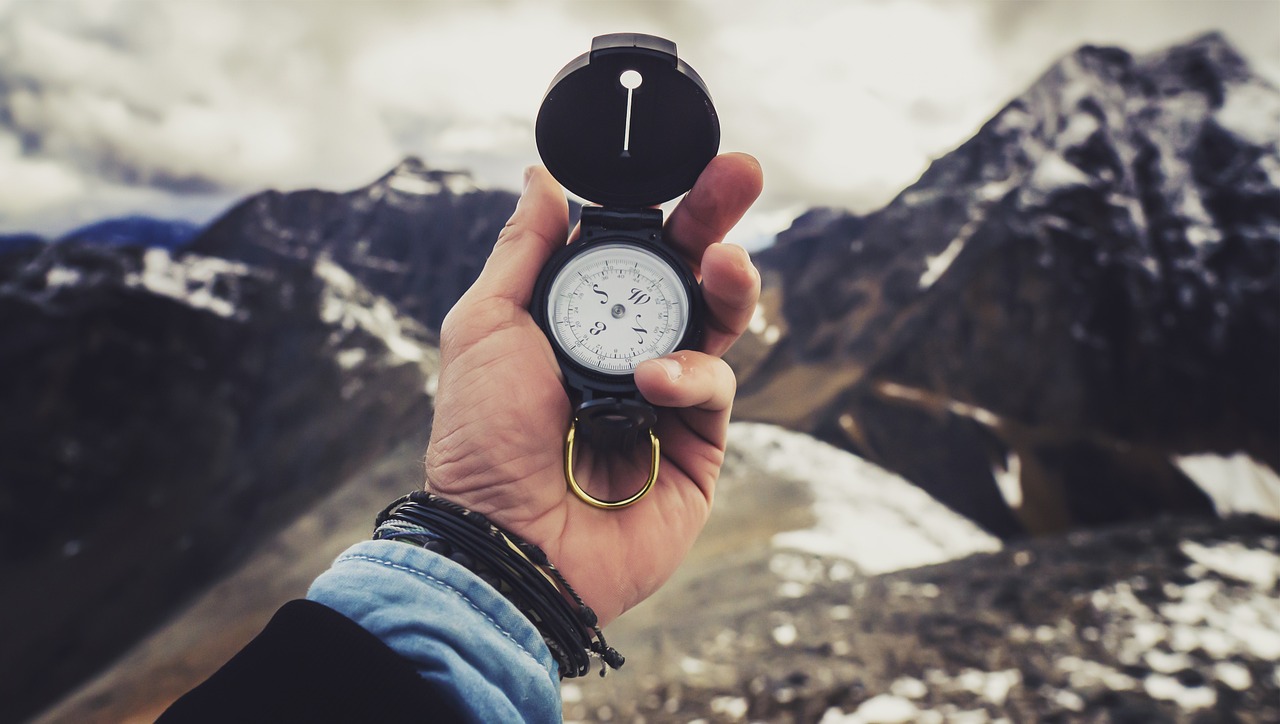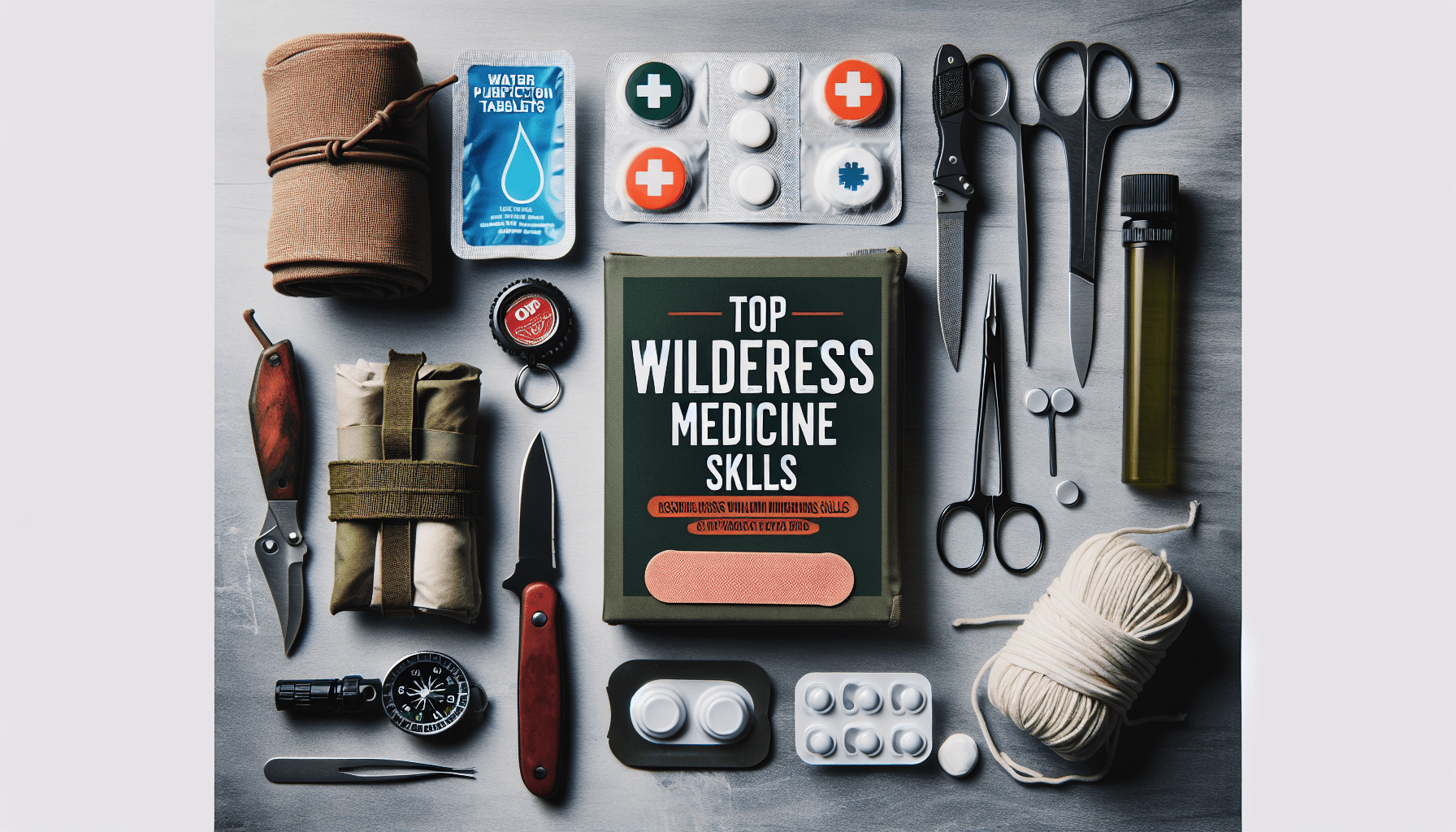In the great outdoors, being equipped with wilderness medicine skills can mean the difference between a minor mishap and a serious emergency. Whether you’re an avid camper, hiker, or simply enjoy exploring the wilderness, knowing how to handle medical situations in remote areas is crucial. From knowing how to perform basic first aid to understanding how to spot the early signs of altitude sickness, this article will explore the top wilderness medicine skills that will ensure your safety and the safety of those around you. Prepare to embark on an adventure filled with knowledge and confidence as you learn these indispensable skills.

Assessment Skills
When it comes to wilderness medicine, having strong assessment skills is paramount. Being able to identify and prioritize injuries quickly can mean the difference between life and death in remote and challenging environments. As a wilderness first responder, it is your responsibility to assess the situation and determine the severity of injuries. This involves conducting a focused physical exam and assessing vital signs.
Identifying and prioritizing injuries
The first step in assessing injuries is to quickly identify the most critical ones. This means looking for any life-threatening conditions such as severe bleeding, compromised breathing, or signs of shock. Once you have addressed these immediate threats, you can then move on to identifying and prioritizing other injuries based on their severity and potential long-term consequences.
Performing a focused physical exam
In a wilderness setting, resources and medical equipment may be limited, so it’s essential to conduct a focused physical exam using only what you have available. This involves inspecting the injured area for external signs of trauma, such as cuts, bruises, or deformities. You should also gently palpate the area to check for any tenderness or abnormalities.
Assessing vital signs
Assessing vital signs is a crucial part of your initial assessment. This includes checking the person’s heart rate, respiratory rate, blood pressure, and body temperature. Abnormalities in vital signs can provide critical information about the person’s condition and guide your treatment decisions. However, it is essential to keep in mind that vital sign norms can vary in different environments, so it’s essential to have a baseline understanding of what is typical in a wilderness setting.
Wound Management
In the wilderness, injuries such as cuts, abrasions, and puncture wounds are common. Proper wound management is essential for preventing infection and promoting healing. As a wilderness first responder, you must be proficient in cleaning and disinfecting wounds, applying appropriate dressings, and knowing when and how to suture.
Cleaning and disinfecting wounds
The first step in wound management is to clean and disinfect the affected area thoroughly. Start by rinsing the wound with clean water to remove any debris or foreign objects. You can also use an antiseptic solution to further cleanse the wound. Carefully remove any dirt or debris with sterile tweezers or forceps. Remember to use gentle and deliberate motions to avoid causing further damage. Once the wound is clean, you can apply an appropriate dressing.
Applying appropriate dressings
Choosing the right dressing is essential for promoting healing and protecting the wound from further contamination. In the wilderness, it’s crucial to have a variety of dressings in your first aid kit, such as sterile gauze pads, adhesive bandages, and self-adherent elastic wrap. Evaluate the size and severity of the wound to determine the best dressing option. Secure the dressing in place with tape or a bandage wrap to ensure it stays in place during movement.
Knowing when and how to suture
In some situations, a wound may be large or deep enough to require sutures. As a wilderness first responder, you must have the knowledge and skills to determine when suturing is necessary and how to perform it properly. Suturing should only be done if the wound is fresh and less than six hours old. It’s important to keep in mind that suturing should be done as a last resort in the wilderness since it increases the risk of infection and requires specialized equipment. However, if suturing is necessary, proper wound cleaning, anesthesia, and sterile technique are crucial.

Fracture and Orthopedic Injuries
Fractures and orthopedic injuries can be particularly challenging in a wilderness setting. You must be prepared to perform splinting techniques to stabilize broken bones, immobilize joint injuries, and recognize and reduce dislocations.
Splinting broken bones
Splinting is a critical skill for managing fractures and broken bones in the wilderness. The main goal of splinting is to stabilize the injury and minimize movement during evacuation. Start by assessing the fracture and the surrounding area for any deformities, swelling, or open wounds. Carefully realign the bones if necessary, using gentle traction and alignment techniques. Once the bones are in position, apply a splint to immobilize the injured limb. This can be done using various materials such as sticks, trekking poles, or SAM splints. Secure the splint firmly but not too tightly to ensure proper blood circulation.
Immobilizing joint injuries
In addition to fractures, joint injuries such as sprains and strains are common in the wilderness. Immobilizing these injuries is crucial to prevent further damage and alleviate pain. Start by gently stabilizing the joint in its current position to reduce movement. Use a combination of splinting materials and bandages to create a secure and supportive wrap around the affected joint. It’s important to monitor the injured person for signs of worsening pain or circulation issues during immobilization.
Recognizing and reducing dislocations
Dislocations occur when a joint becomes displaced, and the bones are no longer in their normal position. As a wilderness first responder, being able to recognize dislocations is essential for providing timely treatment. Signs of a dislocation may include pain, deformity, and limited range of motion. If a dislocation is suspected, it’s crucial to reduce it as soon as possible to relieve pain and prevent further complications. However, dislocations should only be reduced by trained medical professionals with the necessary equipment and expertise.
Burn and Blisters Care
Dealing with burns and blisters in the wilderness requires specific knowledge and skills. From treating burns of varying severity to preventing and managing blisters, as a wilderness first responder, you must be prepared to provide appropriate care and support.
Treating burns of varying severity
Burns can occur in the wilderness due to various factors such as campfires, cooking accidents, or sun exposure. The first step in treating burns is to assess the severity and depth of the burn. Burns are categorized into three degrees – first, second, and third-degree burns. First-degree burns typically involve redness and mild pain, while second and third-degree burns are more severe and may cause blisters, open wounds, and even damage to deeper tissues. To treat minor burns, immediately cool the area with cold water for at least ten minutes and apply a sterile non-stick dressing. For more severe burns, it’s crucial to seek medical attention as soon as possible.
Preventing and treating blisters
Blisters are a common occurrence in the wilderness, especially during long hikes or activities that involve repetitive friction. Preventing blisters starts with wearing appropriate footwear and socks that provide proper cushioning and moisture-wicking capabilities. However, even with precautions, blisters may still develop. If a blister forms, avoid popping it unless it is large, painful, or at risk of breaking open on its own. To treat blisters, clean the area with antiseptic solution and apply a sterile blister pad or dressing. It’s important to monitor the blister for signs of infection and avoid activities that aggravate or increase friction on the affected area.
Managing sunburn and frostbite
Exposure to extreme weather conditions in the wilderness can lead to sunburn and frostbite. Sunburn occurs when the skin is exposed to excessive sunlight, leading to redness, pain, and potential blistering. Preventing sunburn involves using sunscreen with a high SPF, wearing protective clothing, and seeking shade during peak sun hours. If sunburn occurs, provide pain relief by cooling the affected area with cold water, applying aloe vera gel, and providing over-the-counter pain medication if necessary. Frostbite, on the other hand, occurs when body tissues freeze due to prolonged exposure to extreme cold temperatures. Prevention involves wearing appropriate clothing and warming the affected area gradually. If frostbite occurs, gently rewarm the area using warm water or body heat, avoid rubbing or massaging the area, and seek medical attention as soon as possible.

Medical Emergencies
In the wilderness, medical emergencies can happen unexpectedly, and being prepared to handle them is essential. From recognizing and managing anaphylaxis to addressing allergic reactions and administering CPR and basic life support, these skills can make a significant difference in saving lives.
Recognizing and managing anaphylaxis
Anaphylaxis is a severe allergic reaction that can be life-threatening if not treated promptly. It can be triggered by a variety of factors, including insect stings, certain foods, or medications. The early signs of anaphylaxis include itching, hives, swelling, and difficulty breathing. If anaphylaxis is suspected, it’s crucial to administer epinephrine via an auto-injector if available. Additionally, it’s essential to monitor the person’s vital signs, provide respiratory support if necessary, and seek immediate medical attention.
Addressing allergic reactions
Allergic reactions can range from mild to severe and can be caused by various allergens, including insect stings, plants, and certain foods. As a wilderness first responder, being able to recognize and address allergic reactions promptly is crucial. Minor allergic reactions, such as mild itching or a rash, can often be managed with over-the-counter antihistamines. However, severe allergic reactions may require the administration of epinephrine and immediate medical attention.
Administering CPR and basic life support
Cardiopulmonary resuscitation (CPR) and basic life support are vital skills that can help save lives in medical emergencies such as cardiac arrest or near-drowning incidents. If a person is unresponsive, not breathing, or their heart has stopped, it’s crucial to initiate CPR immediately. Start with chest compressions to circulate blood flow and provide oxygen to vital organs. If available, use an automated external defibrillator (AED) to deliver an electric shock to restore the heart’s normal rhythm. Continuous CPR should be performed until medical professionals take over or signs of life return.
Water-Borne Illnesses
Water-borne illnesses are a significant concern in the wilderness, as contaminated water sources can lead to severe dehydration and infections. As a wilderness first responder, you must be prepared to prevent and treat dehydration, manage water-borne infections, and handle water purification and filtration.
Preventing and treating dehydration
Dehydration can occur rapidly in the wilderness, especially in hot and dry climates. Prevention starts with staying hydrated by drinking enough water and avoiding excessive sweating. Encourage others to drink frequently and rest in shaded areas when necessary. If dehydration occurs, provide oral rehydration solutions if available, and monitor the person’s vital signs. Severe dehydration may require intravenous fluids and immediate medical attention.
Managing water-borne infections
Water from natural sources in the wilderness, such as streams or lakes, can be contaminated with bacteria, viruses, or parasites. As a wilderness first responder, it’s crucial to recognize and manage water-borne infections. Symptoms of water-borne infections may include diarrhea, vomiting, abdominal pain, and fever. If someone presents with these symptoms, it’s important to provide supportive care, such as oral rehydration and anti-nausea medications, while seeking medical attention.
Handling water purification and filtration
To prevent water-borne illnesses, it’s necessary to have access to safe drinking water. In the wilderness, where clean water sources may be limited, it’s crucial to have knowledge of water purification and filtration techniques. Boiling water is the most effective method to kill most pathogens, but it may not always be feasible. Alternative methods such as using water filters, chemical treatments, or ultraviolet (UV) light can also be effective in purifying water. However, it’s important to follow the manufacturer’s instructions and be aware of the limitations and maintenance requirements of each method.

Environmental and Altitude-related Challenges
The wilderness presents unique environmental and altitude-related challenges that can have a significant impact on one’s health. Being able to recognize and manage conditions such as hypothermia, frostbite, high altitude sickness, and heat-related illnesses is essential.
Recognizing and managing hypothermia and frostbite
Hypothermia occurs when the body’s core temperature drops below normal levels due to exposure to cold temperatures. Early signs of hypothermia include shivering, confusion, and loss of coordination. If hypothermia is suspected, it’s important to move the person to a warm and sheltered area, remove wet clothing, and wrap them in warm blankets or sleeping bags. Gradually rewarm the person, taking care to avoid direct heat sources. Frostbite, as mentioned earlier, occurs when body tissues freeze due to prolonged exposure to extreme cold temperatures. Proper prevention, such as wearing appropriate clothing and keeping extremities warm, is crucial. If frostbite occurs, gently rewarm the affected area using body heat or warm water and seek immediate medical attention.
Adapting to high altitude and acclimatization
Hiking or traveling to high altitude locations can pose unique health risks due to decreased oxygen levels in the air. As a wilderness first responder, understanding altitude sickness and the process of acclimatization is essential. Altitude sickness can range from mild symptoms such as headache and dizziness to more severe forms such as high altitude pulmonary edema (HAPE) or high altitude cerebral edema (HACE). To prevent altitude sickness, it’s important to ascend gradually, stay hydrated, and be aware of your body’s response to the altitude. If symptoms of altitude sickness occur, it’s crucial to descend to a lower altitude and seek medical attention if necessary.
Heat exhaustion and heat stroke management
In hot and humid environments, heat exhaustion and heat stroke are significant concerns. Heat exhaustion occurs when the body becomes dehydrated and overheated, leading to symptoms such as profuse sweating, dizziness, and nausea. If someone shows signs of heat exhaustion, it’s crucial to move them to a cool and shaded area, provide oral rehydration, and cool their body with cold compresses or a cool water mist. Heat stroke is a severe condition that occurs when the body’s internal temperature rises to dangerous levels. It is a medical emergency that requires immediate attention. If someone shows signs of heat stroke, such as hot and dry skin, confusion, or loss of consciousness, call for emergency assistance and move the person to a cool area. Rapid cooling measures such as cold water immersion or ice packs should be initiated while waiting for medical help.
Improvised First Aid Techniques
In the wilderness, you may find yourself in situations where specialized medical equipment is not readily available. Improvisation and resourcefulness become essential skills for providing first aid. These techniques can include creating bandages and slings from available resources, making makeshift splints, and performing CPR without specialized equipment.
Using available resources to create bandages and slings
When faced with a limb injury in the wilderness, improvising bandages and slings can be a crucial skill. Look for suitable materials such as clothing, towels, or even strips of fabric. Start by immobilizing the injured limb using the available resources. It’s important to ensure that the bandage or sling is snug but not too tight to maintain proper circulation. Adjustments may be necessary as swelling or discomfort occurs.
Creating makeshift splints
Splinting an injury is crucial for minimizing movement and preventing further damage. In a wilderness setting, you may need to create makeshift splints using available materials such as sticks, trekking poles, or even rolled-up clothing. Place the splint alongside the injured limb and secure it in place using strips of fabric or adhesive tape. The goal is to immobilize the injury effectively while providing support and stability.
Performing CPR without specialized equipment
In situations where specialized CPR equipment such as pocket masks or bag valve masks are not available, it’s still crucial to know how to perform CPR effectively using basic techniques. Start with chest compressions to circulate blood flow and provide oxygen to vital organs. If possible, cover the person’s mouth and nose with a clean cloth or your hand to minimize the risk of disease transmission. Focus on providing high-quality compressions at the correct depth and rate until help arrives or signs of life return.

Snakebites and Insect Stings
Encounters with venomous snakes and insect stings are potential risks in the wilderness. Being able to identify venomous snakes, administer appropriate treatment for snakebites, manage allergic reactions to insect stings, and utilize venom extractors can be life-saving skills.
Identifying venomous snakes and treating snakebites
Snakebites can be a serious medical emergency, especially if the snake is venomous. It’s crucial to be able to identify venomous snakes found in your region and understand the appropriate treatment protocols. If someone is bitten by a venomous snake, prioritize their safety and try to identify the snake if possible. Keep the person still and immobilized to slow down the spread of venom. Seek immediate medical attention and provide basic first aid measures such as cleaning the wound, applying a pressure immobilization bandage, and keeping the affected limb below heart level.
Managing allergic reactions to insect stings
Insect stings, such as those from bees, wasps, or ants, can trigger allergic reactions in some individuals. If someone shows signs of an allergic reaction to an insect sting, it’s important to assess the severity and provide appropriate care. Mild allergic reactions can often be managed with over-the-counter antihistamines and cold compresses to reduce swelling. However, severe allergic reactions, known as anaphylaxis, require immediate medical attention and the administration of epinephrine if available.
Using the Sawyer Extractor for venom extraction
The Sawyer Extractor is a vacuum pump device designed to remove venom from snakebites and insect stings. While it is not a substitute for medical treatment, it can be a useful tool to remove some of the venom from the wound. To use the Sawyer Extractor, place the appropriate suction cup over the bite or sting area and use the pump to create a vacuum. Follow the manufacturer’s instructions and be aware of the limitations of the device. Remember to seek medical attention as soon as possible, even if venom extraction has been performed.
Communication and Evacuation
Communication and evacuation strategies are essential in remote wilderness areas where access to medical facilities may be limited. Being able to build effective communication strategies, prepare for wilderness evacuation, and create a wilderness first aid kit can help ensure a successful outcome in emergencies.
Building effective communication strategies in remote areas
In the wilderness, reliable communication is crucial for seeking help and coordinating evacuation. However, remote areas may have limited or no cell phone reception. Be prepared by carrying alternative communication devices such as satellite phones, two-way radios, or personal locator beacons (PLBs). Establish communication protocols within your group, including designated frequencies or channels and agreed-upon distress signals or codewords. It’s vital to practice using these communication devices before your wilderness adventure and have a backup plan in case of equipment failure.
Preparing for wilderness evacuation
In a medical emergency, timely evacuation from the wilderness to a medical facility can be lifesaving. As a wilderness first responder, you must be prepared to initiate and facilitate evacuation procedures. Start by assessing the person’s condition and considering the severity of the injury or illness. If evacuation is necessary, determine the best method based on the circumstances, such as self-evacuation, calling for assistance, or activating an emergency response system. Ensure that you have the necessary equipment, such as a sturdy litter or improvised stretcher, and the means to transport the injured person safely. Keep in mind that evacuation routes and available resources may vary depending on the location, so it’s important to be familiar with the area and have evacuation plans in place.
Creating a wilderness first aid kit
A well-prepared wilderness first aid kit is essential for addressing a wide range of medical emergencies. Your first aid kit should be tailored to the specific needs of your group and the activities you’ll be undertaking. Some essential items to include are adhesive bandages, sterile gauze pads, adhesive tape, antiseptic wipes, antihistamines, tweezers, scissors, splinting materials, pain relievers, sunscreen, insect repellent, and your preferred method of water purification. It’s important to regularly check and restock your first aid kit, ensuring that all items are within their expiration dates.
In conclusion, wilderness medicine requires a diverse skill set and the ability to adapt to challenging environments. From assessing and prioritizing injuries to managing medical emergencies and improvising first aid techniques, being a competent wilderness first responder is essential for providing effective care in remote locations. By continuously improving your knowledge and skills in the areas of assessment, wound management, fractures and orthopedic injuries, burn and blister care, medical emergencies, water-borne illnesses, environmental challenges, improvised techniques, snakebites and insect stings, communication, and evacuation, you can be well-prepared to handle a wide range of emergencies, ensuring the safety and well-being of yourself and those around you in the wilderness.
